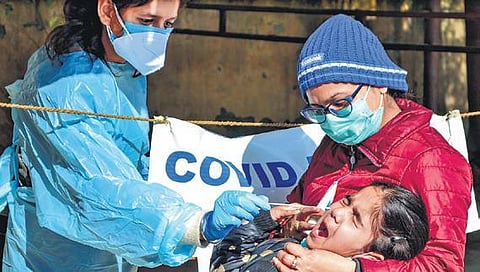

NEW DELHI: More children below five years were admitted to hospitals in India during the third Covid wave as compared to the first and second wave due to the reopening of schools, said the latest ICMR study.
Most children who died were infants, said the study, which analysed the National Clinical Registry for COVID-19, a platform which collects real-time Covid data, set up by the Indian Council of Medical Research (ICMR) in collaboration with the Union Health Ministry, AIIMS, and the ICMR-National Institute of Medical Statistics.
The study, which studied the impact of Covid in the three waves on the children, confirmed that Covid-19 was milder in children than adults, and the pattern was consistent across all three waves. The other reason children were hospitalised more during the third wave, which was termed milder as compared to the first and second wave, was the unvaccinated status of the below 18 years population, said the study, published in the Indian Journal of Pediatrics.
The study said of the 1,244 enrolled hospitalised Covid-19 patients aged between 0–18 years, 98 and 124 were infants and neonates, respectively. Of 1,244 Covid-positive children, 67 (or 6.2%) died during hospital stay, and the reason mainly was altered sensorium (unconscious); WHO ordinal scale ≥4 at admission (severe case in need of hospitalisation with oxygen support) and malignancy (cancer).
The proportion of deaths was highest in the age group of one month to 1 year (12.5%), followed by neonates (7.2%), five to nine years (6.4%), 10–18 years (5.7%), and then one to four years of children (2.4%). “Mortality rates were similar across the three waves of the pandemic, though a significant shift towards the under-five group was observed in the third wave,” said the study, which was held to evaluate the factors associated with mortality of a multi-centric cohort of hospitalised Covid-19 children from 42 hospitals across India.
Only 68.6% of children were symptomatic at admission, with fever being the most common symptom – similar to symptoms in adults. Diarrhoea, rash, and neurological symptoms were also noted. Gastrointestinal symptoms were seen among children between 1 and five years of age. Most children stayed in the hospital for four to six days. Of the 1244 admitted children, 260 (21%) had at least one co-morbidity.
Neurological symptoms such as altered consciousness and seizures were also observed in some infants. Most children stayed in the hospital for four to six days. Of the 1244 admitted children, 260 (21 per cent) had at least one co-morbidity.
The most common co-morbidity among children over one year of age was hematologic disorders (blood-related problems) and malignancy, while the cardiac disease was more common among infants. Neonates did not report any co-morbidities.
The study said that the three waves of children admitted with co-morbidities and mortality were not significantly different. Still, during the third wave, a change was seen among those under five. The study also said that oxygen supplementation was required by 23.8 per cent of patients, while non-invasive and mechanical ventilation were required by 4.1 per cent and 6.3 per cent, respectively.
The use of steroids was lowest among neonates (9.2 per cent), with the highest usage among the 10–18 age group (17.8 per cent). Oxygen requirements and invasive and non-invasive ventilation were highest among children under one year of age. The most commonly prescribed drug was azithromycin, steroids, doxycycline, ivermectin and anticoagulants, the study found.
“It seems that many of the pediatric admissions were either for monitoring or as an add-on diagnosis upon some other existing condition,” the study added.